A perfectly cooked, full-flavored, tender, and juicy Reverse Seared Ribeye Steak is glorious and the ultimate steak dinner. In this easy recipe, a bone-in ribeye steak is first roasted low-and-slow in the oven and then pan-seared in a cast-iron skillet on the stove until it develops a tasty crust.
Bone-in ribeye steaks are known for their exceptional beefy taste and beautiful marbling. They are perfect for reverse searing, and the best part is this cooking method is easy enough even for novice cooks.
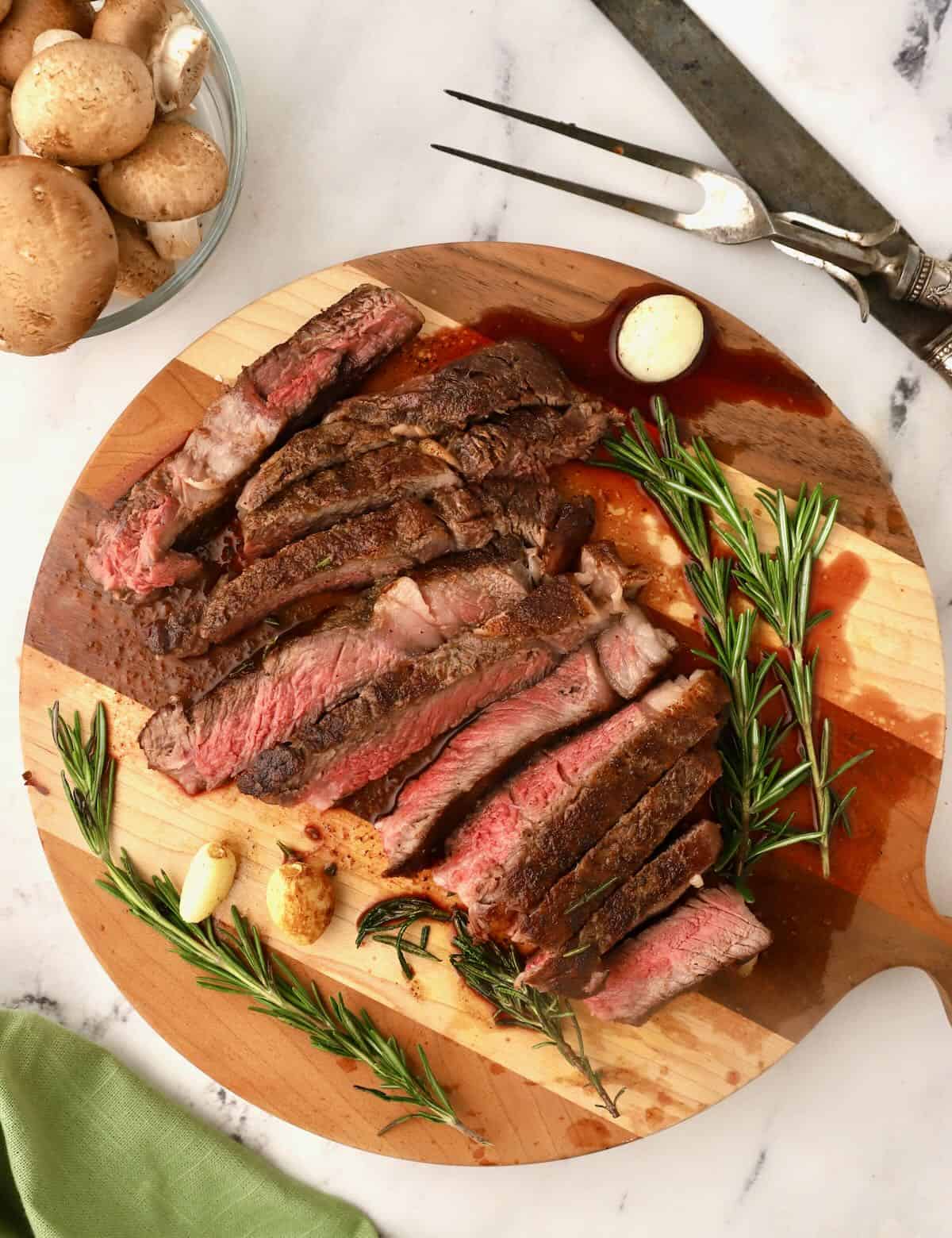
Ribeye steaks are my favorite cut of beef. The outside edge, called the ribeye cap or spinalis, is the richest, most tender part. While beef tenderloin or filets are considered the most tender cut of beef, ribeyes are, by far, the most flavorful.
If you like as we do you might also want to check out my recipes for Smoked Ribeye Steak and Garlic Butter Steak Bites.
Ingredients – here’s what you need:
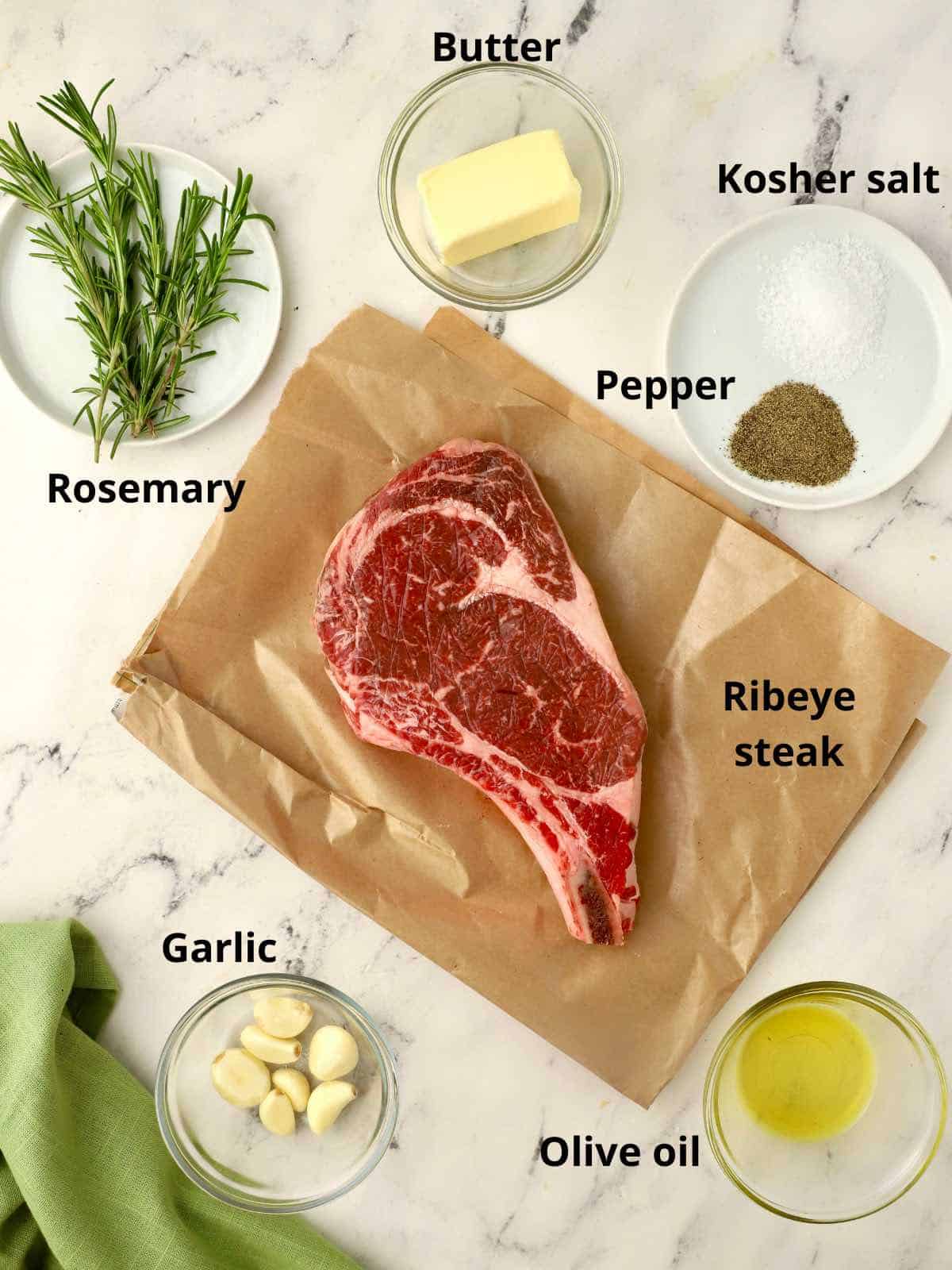
- Bone-in Ribeye Steak – at least one and one-half to two inches thick. Any thinner, and you run the risk of overcooking it. Also, it’s better to cook one large steak for two people than two smaller ones. You can also use boneless ribeyes, New York strip steaks, tenderloin filets, T-bones, or porterhouse steaks in this recipe.
- Kosher salt and ground black pepper – combine to season the beef to perfection.
- Butter and oil – first, the ribeye is pan-seared in vegetable oil. Then, butter is added to provide a browned, crispy crust and add even more rich flavor.
- Garlic cloves – enhance the flavor of the beef with their garlicky essence. Leave the cloves whole; chopped garlic will burn and taste bitter.
- Rosemary – stands up well to pan-searing and adds a wonderful aroma and taste to the beef. If you don’t have any, you can leave it out.
Directions – here’s how to make this recipe:
- Preheat the oven to 225 degrees F.
- Use a paper towel and pat the ribeye dry to remove excess moisture. Sprinkle salt and pepper evenly on the top and bottom.
- Place the seasoned steak on a wire rack over a rimmed baking sheet.
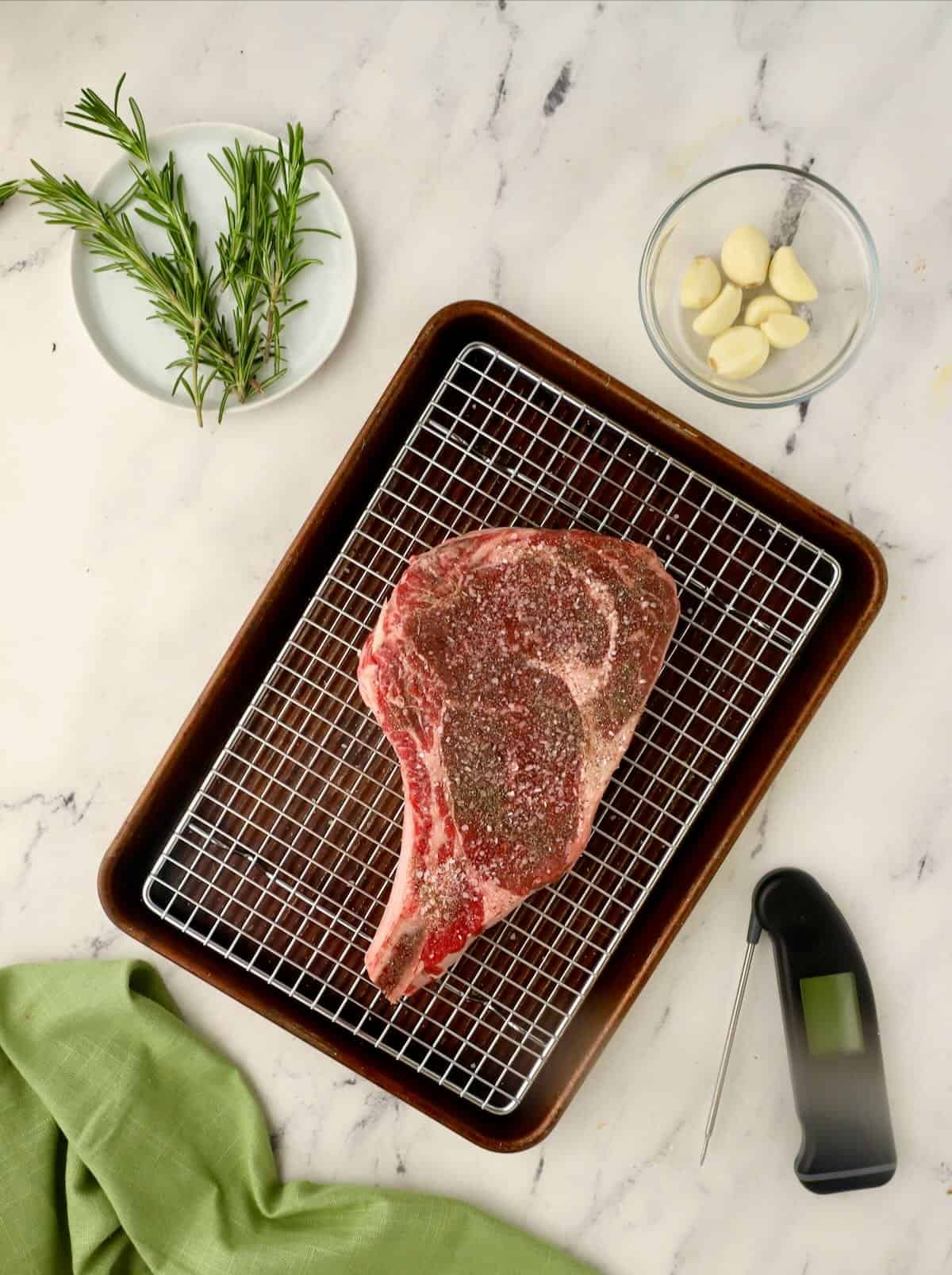
- Then, place the pan in the oven. Roast the ribeye until the internal temperature reaches 105 degrees F. for rare, 115 degrees F. for medium-rare, and 125 degrees F. for medium. This will take one to two hours for a two-pound bone-in ribeye at 225 degrees F. The steak will not be done; it will finish cooking in the skillet.
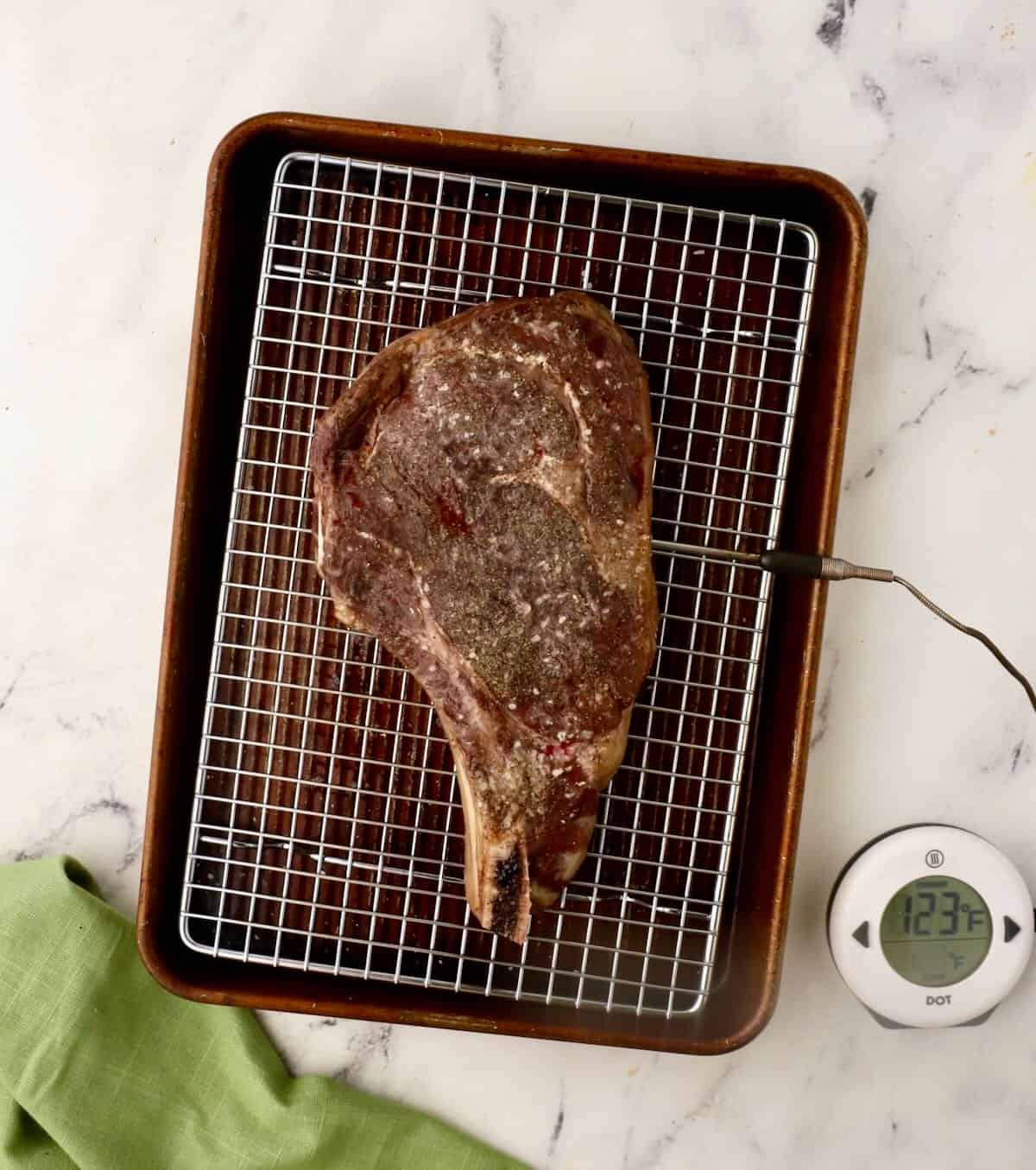
- Heat a large cast-iron skillet over medium-high heat about five minutes before you think your steak will be done. When the skillet is hot, add the oil.
- When the oil starts shimmering, add the ribeye and sear on the first side for one to two minutes. Next, add the butter, garlic cloves, and rosemary sprigs, and flip the ribeye over. Sear on the second side for one to two minutes while continuously spooning the butter over it.

- Use tongs and sear the edges by setting the ribeye on its side and on the top for about one minute to sear the ribeye cap or spinalis.
- Remove the steak from the pan. Cover it loosely with aluminum foil and let it rest for 10 minutes. Carryover cooking will continue to increase the internal temperature. Final internal temperatures are approximately 120 degrees F. for rare, 130 degrees for medium-rare, and 135 degrees for medium.
- Before serving, use a sharp knife to cut the bone away, and cut the ribeye into slices. Spoon the butter mixture over the slices and serve immediately.
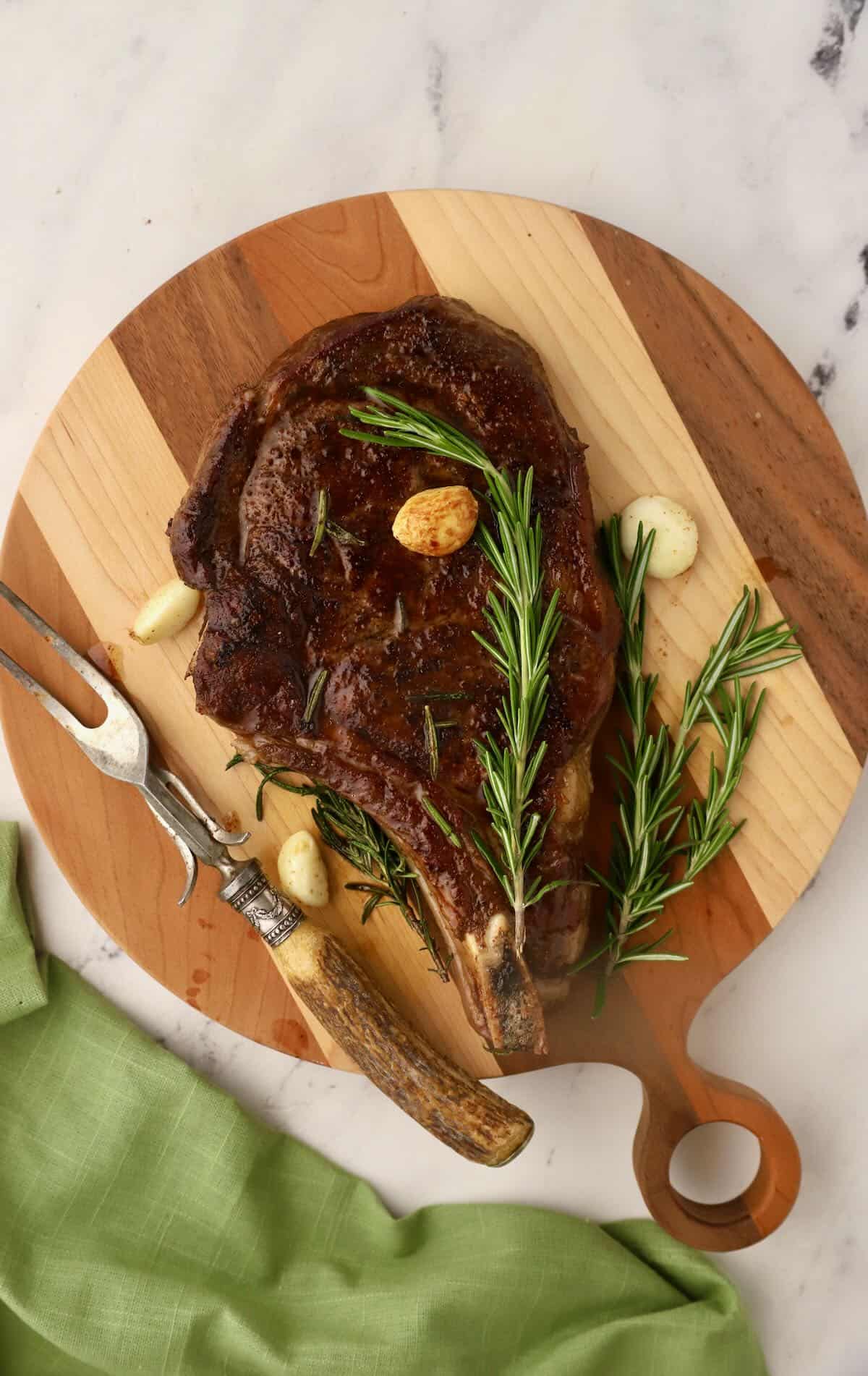
Frequently asked questions:
Reverse searing is simply the reverse of the usual method of cooking a thick cut of meat such as a ribeye, cowboy, or tomahawk steak: which is to first pan-sear it on the stove, then let it finish cooking in the oven.
With reverse searing, first, you cook the ribeye at a gentle, low heat in the oven or on a grill, which keeps the interior tender and juicy. Then it is seared in a screaming hot skillet on the stove or over a hot fire on a grill to sear the surface for a nice browned crust. Reverse searing gives you more control over nailing your preferred level of doneness while maximizing the flavor and texture of the meat.
In addition to ribeyes, other cuts of beef and pork also benefit from cooking with the reverse sear method, such as my Reverse Seared Pork Steaks.
Believe it or not, the perfect oven temperature for reverse searing a ribeye is 225 degrees F. Similar to the sous vide method of cooking at a low controlled temperature, reverse searing allows the meat’s interior to cook slowly and evenly before searing the outside.
I know you may be tired of me saying this, but steak is too expensive to guess whether or not it is properly cooked. You should always use an instant-read meat thermometer to ensure your meat is cooked to the perfect temperature.
For a recipe like this, I like to use two meat thermometers. First, I use a DOT oven alarm with a probe. Then, I set the target temperature, insert the probe in the thickest part of the beef, not touching the bone, and then an alarm beeps when the desired temperature is achieved.
As additional insurance, I also use a Thermopen instant-read thermometer. When my DOT alarm goes off, I verify that the beef is at the proper temperature by inserting the temperature probe into different parts of the steak. No guessing here and possibly ruining a perfectly good steak by overcooking it.
Meat thermometers are relatively inexpensive and available online or at most grocery stores. Please do yourself a favor and get one if you don’t have one.
If you don’t have a meat thermometer, the only way to see if your meat is done is to make a small cut into the center to inspect it visually.
Everything I have read says that when using the reverse sear cooking method, you do not have to let the meat rest. However, I have found that for the best results, it is beneficial to cover the ribeye loosely with foil and allow it to rest for ten minutes before slicing and serving it.
Sharon’s tips:
- This reverse sear ribeye steak recipe is based on a bone-in, two-inch-thick ribeye weighing approximately 2 to 2.5 lbs. Steaks that are one and one-half to two inches thick are the perfect thickness for reverse searing. However, this cooking method isn’t recommended if your meat is thinner than this because it will cook too quickly.
- If your steak is more or less than two to two and one-half pounds, cooking times will be longer or shorter.
- I like my beef medium-rare, and my husband likes his medium. So, I compromised when cooking the ribeye pictured and pulled it out of the oven when the internal temperature reached 120 degrees F.
- For an even tastier ribeye, If you have time, before cooking, place your uncooked and unwrapped ribeye on a wire rack over the baking sheet. Sprinkle the salt over it, then put it uncovered in the fridge overnight. This allows any moisture to be drawn out and evaporate and helps to concentrate the flavor. Then follow the recipe and cook as directed.
- This recipe calls for kosher salt. If you are using table salt, reduce the amount by half.
More steak recipes:
If you like a good steak, as I do, I know you will also love these popular recipes:
- Ultimate Grilled Flank Steak
- Chili Rubbed Ribeye Steak with Maple Bourbon Butter
- Filet Mignon with Blue Cheese Crust
- Filet Mignon with Mushroom Red Wine Sauce
If you need more menu ideas or recipes, check out all of my beef recipes at this link.
⭐️⭐️⭐️ ⭐️ ⭐️ If you make this recipe, please leave a comment and give it a star rating. I would love to know how you liked it!
Thank you so much for visiting Grits and Pinecones!
Recipe:
Want to Save This Recipe?
Enter your email & I’ll send it to your inbox. Plus, get great new recipes from me every week!
By submitting this form, you consent to receive emails from Grits and Pinecones.
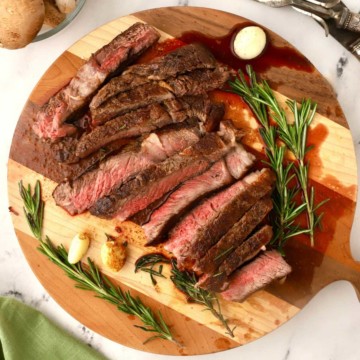
Easy Reverse Seared Ribeye Steak Recipe in the Oven
Equipment
- wire rack, rimmed baking sheet, large cast iron skillet, instant read meat thermometer
Ingredients
- 2 pounds bone-in ribeye steak 2 to 2.5 pounds, 1.5 to 2inches thick
- 1 teaspoon kosher salt
- ½ teaspoon ground black pepper
- 2 tablespoons vegetable oil or peanut oil
- 4 tablespoons unsalted butter you can also use ghee or clarified butter
- 3-4 whole garlic cloves peeled
- 2-3 sprigs of rosemary
Instructions
- Preheat the oven to 225 degrees F.
- Sprinkle the salt and pepper on all sides of the steak.
- Place the seasoned steak on a wire rack over a rimmed baking sheet.
- Then, place the pan in the oven. Roast the ribeye until the internal temperature reaches 105 degrees F. for rare, 115 degrees F. for medium-rare, and 125 degrees F. for medium. This will take one to two hours for a two-pound bone-in ribeye at 225 degrees F. The steak will not be done; it will finish cooking in the skillet.
- Heat a large cast-iron skillet over medium-high heat about five minutes before you think your steak will be done. When the skillet is hot, add the oil.
- When the oil starts shimmering, add the ribeye and sear on the first side for one to two minutes. Next, add the butter, garlic cloves, and rosemary sprigs, and flip the ribeye over. Sear on the second side for one to two minutes while continuously spooning the butter over it.
- Use tongs and sear the edges by setting the ribeye on its side and on the top for about one minute to sear the ribeye cap or spinalis.
- Remove the steak from the pan. Cover it loosely with aluminum foil and let it rest for 10 minutes. Carryover cooking will continue to increase the internal temperature. Final internal temperatures are approximately 120 degrees F. for rare, 130 degrees for medium-rare, and 135 degrees for medium.
- Before serving, use a sharp knife to cut the bone away, and cut the ribeye into slices. Spoon the butter mixture over the slices and serve immediately.
Notes
- This reverse sear ribeye steak recipe is based on a bone-in, two-inch-thick ribeye weighing approximately 2 to 2.5 lbs. Steaks that are one and one-half to two inches thick are the perfect thickness for reverse searing. However, this cooking method isn’t recommended if your meat is thinner than this because it will cook too quickly.
- If your steak is more or less than two to two and one-half pounds, cooking times will be longer or shorter.
- I like my beef medium-rare, and my husband likes his medium. So, I compromised when cooking the ribeye pictured and pulled it out of the oven when the internal temperature reached 120 degrees F.
- For an even tastier ribeye, If you have time, before cooking, place your uncooked and unwrapped ribeye on a wire rack over the baking sheet. Sprinkle the salt over it, then put it uncovered in the fridge overnight. This allows any moisture to be drawn out and evaporate and helps to concentrate the flavor. Then follow the recipe and cook as directed.
- This recipe calls for kosher salt. If you are using table salt, reduce the amount by half.




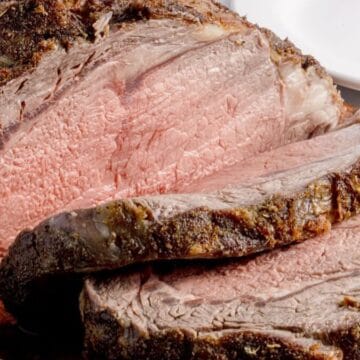


elle
Hi! I want to try salting the steak overnight, but when I’m ready to cook it – do I brush off that salt and then season with salt & pepper? or just add pepper? am afraid it will be too salty.
Sharon Rigsby
Hi Elle, go ahead and salt it with the teaspoon of kosher salt before you put it in the fridge. But do not add any additional salt before cooking it and you should be fine.
I hope you enjoy it!
Sharon
Lisa
Fantastic recipe! Just made this tonight for Valentine’s Day and my husband and I loved it! So tender and juicy! It took about an hour and 50 minutes to reach 120 in the oven. It seared so perfectly too. We had slightly over a 2 pound ribeye steak. The 2 inch thick steak is just so perfect for this. This was the best steak I have ever made. Thank you for such a wonderful recipe! Definitely a keeper! 🙂
Linger
You have just made me so hungry Sharon!! Wow, this looks so juicy and delicious. Love your photos and love all the tips you give for cooking a reverse seared steak. Your posts are always so informative. Thanks so much for sharing.